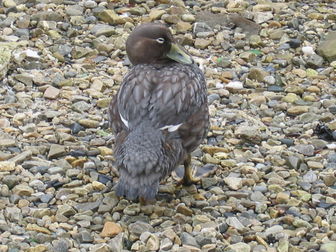Falkland Steamerduck
The Falkland Steamer Duck's wings are very short , and it is incapable of flight. The plumage of the Falkland Steamer Duck is mostly dark grey, but with a white stripe behind the eye. It is very difficult to distinguish from the Flying Steamer Duck in the field since they occupy the same habitat and, although the Flying Steamer Duck can fly, it rarely does.

Original source: PismirePermission(Reusing this file)GFDL
Author: PismirePermission(Reusing this file)GFDL
Permission: GNU Free Documentation License
The Falkland Steamerduck is classified as Least Concern. Does not qualify for a more at risk category. Widespread and abundant taxa are included in this category.
The Falkland Steamerduck, Tachyeres brachypterus, is a duck native to the Falkland Islands in the southern Atlantic Ocean. It is one of only two bird species to be endemic to the Falkland Islands (Islas Malvinas in Spanish), the other being Cobb's Wren. The Falkland Steamerduck's wings are very short (hence the scientific name: brachy = "short", and pteron = "wing"), and it is incapable of flight. The plumage of the Falkland Steamerduck is mostly dark grey, but with a white stripe behind the eye. More
The Falkland Steamerduck, Tachyeres brachypterus, is a Duck native to the Falkland Islands in the southern Atlantic Ocean. Chordates ( Phylum Chordata) are a group of Animals that includes the Vertebrates together with several closely related Invertebrates Birds ( class Aves) are bipedal endothermic ( Warm-blooded) Vertebrate animals that lay eggs. More
Falkland Steamerduck (on 1960 Birds, 1999 Ducks and 2003 Birds definitives). More
Family : Anatidae
Genus : Tachyeres
Species : brachypterus
Authority : (Gmelin, 1789)

